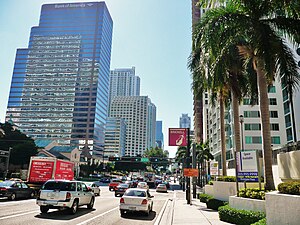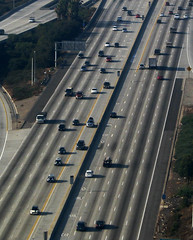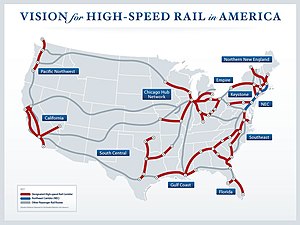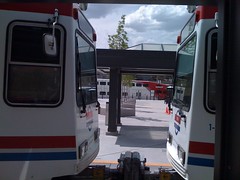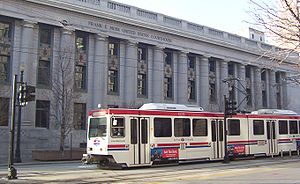 Image via Wikipedia
Image via WikipediaWe are privileged to present the following commentary by Russ Jackson. Russ is a decades-long URPA vice president. He is also a founding member and Secretary of the Rail Passenger Association of California (RailPAC); the largest, most active rail passenger advocacy group in that state. Russ regularly attends and reports on state rail meetings of the San Joaquin, Coast Rail, and Capitol Corridors.
The passenger trains operated by the Atchison, Topeka & Santa Fe Railway between Chicago and the West Coast are the stuff of legend. Their post-war fleets of stainless steel trains were, and are, considered the gold standard for American passenger railroading. Everybody knows the Super Chief ran over Raton Pass. They forget that the El Capitan was a separate train for most of its existence, but they vaguely remember that there was a different train called the Chief that also ran over Raton Pass. They remember that the San Francisco Chief ran through Amarillo, but they forget that the line through Amarillo also saw half of a train called the Grand Canyon; the other half of the Grand Canyon ran over Raton Pass!
Something else that apparently few people remember is that right up until Amtrak, the Santa Fe served Denver directly, with service between Denver and La Junta. In fact, there were two round trips per day until 1967. There were two trains a day through Amarillo before the Postal cuts in 1967, and there was one train daily right up until Amtrak.
It has been proposed that the one remnant of this once-proud lineage, Amtrak’s Southwest Chief, be rerouted some 790 miles off its current route through Raton Pass to the prominent BNSF Railway transcontinental mainline through Amarillo. This week, Mr. Jackson examines this proposition.
What Happens if the Southwest Chief is Rerouted?
Commentary by Russ Jackson, RailPAC
Every once in a while, the rerouting of Amtrak Trains 3 and 4, the Southwest Chief, off the traditional line from Albuquerque, New Mexico to Hutchinson, Kansas arises, because the line has virtually no BNSF freight traffic in Colorado and New Mexico any longer. That is a true statement. The railroad no longer uses the Chief, and has diverted through freights to the soon-to-be fully double-tracked "Transcon" line, farther south. This was the historic route of Santa Fe's San Francisco Chief prior to Amtrak. In recent months, Amtrak has been forced to add 40 minutes to the Chief's schedule due to a BNSF lowering of the speed limit on the very rough trackage in western Kansas and Colorado, such that Train 4 now departs Los Angeles at 6:15 PM. The BNSF has offered to move the train to the Transcon line, which as we will see, is more populated. The State of New Mexico now owns the line within its borders and runs the very successful Railrunner trains on the portion south of Santa Fe to Albuquerque. The BNSF still owns the rest.
Well then, what would happen if Amtrak had to abandon the line?
Would New Mexico pay to maintain the line through Raton Pass? Would Colorado step up and pay to maintain their portion of the line? Would Kansas pay? Would a "short line" purchase it, knowing there are almost no freight customers? Would Amtrak pay a higher share of the maintenance? Would anyone pay to rebuild it? Would the BNSF pay for a portion of an abandoned line? The answers to these questions are likely to be "No."
All right, then what would be lost in a reroute?
Certainly, there is the loss of the "absolutely spectacular and incomparable" scenic route through Raton Pass, as stated by URPA's Bruce Richardson, "but how many millions of dollars a year in track maintenance is that scenery worth?" In this case economics will eventually govern the results, even though Amtrak CEO Joseph Boardman has said he is "not interested in" moving the train.
Here are the FY ‘09 Amtrak ridership and revenue statistics for the abandoned towns; but not including Albuquerque, as that ridership could be largely retained by having the Railrunner act as a shuttle to Belen, thereby avoiding Amtrak’s having to back up into Albuquerque.
Station FY09 Riders FY09 Revenue
Lamy, NM 13,012 $1,623,108
Las Vegas, NM 4,456 335,144
Raton, NM 15,066 1,572,789
La Junta, CO 6,809 658,928
Lamar, CO 1,722 162,363
Trinidad, CO 3,923 388,961
Dodge City, KS 4,248 429,647
Garden City, KS 6,930 712,501
Hutchinson, KS 4,045 396,749
Totals 60,211 $6,280,190
(Statistics found on Great American Stations)
To Amtrak Accounting, that might be "chump change," but to the people who live in those towns and use the train it can be a matter of life and death, just as was the case for the Empire Builder across North Dakota and Montana.
Yes, there is also a human cost. On my October trip to northern New Mexico, I stopped for a visit at the Las Vegas, NM, Amtrak station, which is not staffed by Amtrak but is the city's nicely-restored Intermodal Facility in the Historic Railroad District. Employees handle questions about Amtrak travel, and there is a Quik-Trak ticket machine.
Transportation Facility Manager Debra Trujillo was aware there was talk of a potential loss of the train, and expressed concern for her town's people, many of whom are senior citizens who would have no transportation alternative. Greyhound does not serve the town. She said many people ride the train to Albuquerque for medical appointments, or into Colorado to visit relatives. While dealing with Amtrak can be difficult, she is looking forward to the American Recovery and Reinvestment Act (ARRA) stimulus-money-funded new, ADA-compliant platform; although as of the date of my visit, construction had not yet begun. I urged Manager Trujillo to let Amtrak and the political establishment know how important the train is to her city, and to muster the other cities on the route to do the same.
What would Amtrak gain by rerouting the train?
Many observers felt Amtrak should have also retained the San Francisco Chief when it began in 1971. To go into these towns now would mean they would be starting over, selling rail passenger service after 40 years of absence. Here are the current populations of the new station cities, not their metro areas. It is not a prediction of ridership, but one can certainly see the temptation to reach out to new customers. The towns listed below are not all the stations that were served by the Santa Fe's train, but are the most likely stops:
Station Population
Vaughn, NM (flag stop?) 463
Clovis-Portales, NM 45,124
Hereford, TX 14,455
Amarillo-Canyon, TX 200,183
(major university at Canyon)
Pampa, TX 17,204
Alva, OK 4,738
Woodward, OK 12,206
Wellington, KS 7,812
Wichita, KS 361,420
(Statistics from Rand McNally map book)
Eventually, the decision may be out of the hands of the cities, the railroad or Amtrak. That would be unfortunate and would probably be a big black eye for all. The BNSF's Joseph Faust told the Amarillo Globe-News on October 8 that Amtrak is free to use the freight tracks in Amarillo, but that option "would require a great deal of study." The historic passenger station is used by an auction house, but is still standing; as is the brick platform. Amtrak's Marc Magliari told the newspaper, "Right now (the delays) are not significant. Our intention is to stay on the current route."
This writer urges all parties to work to preserve this service area and work to restore the San Francisco Chief into the Amtrak long-distance system; yes, to San Francisco from Barstow, up the San Joaquin Valley. That would be a bonanza for Amtrak ridership and revenue. Years ago, the Amtrak agent in Stockton told me that he could fill a sleeping car on the train every day, in the old days. Think future, Amtrak!







